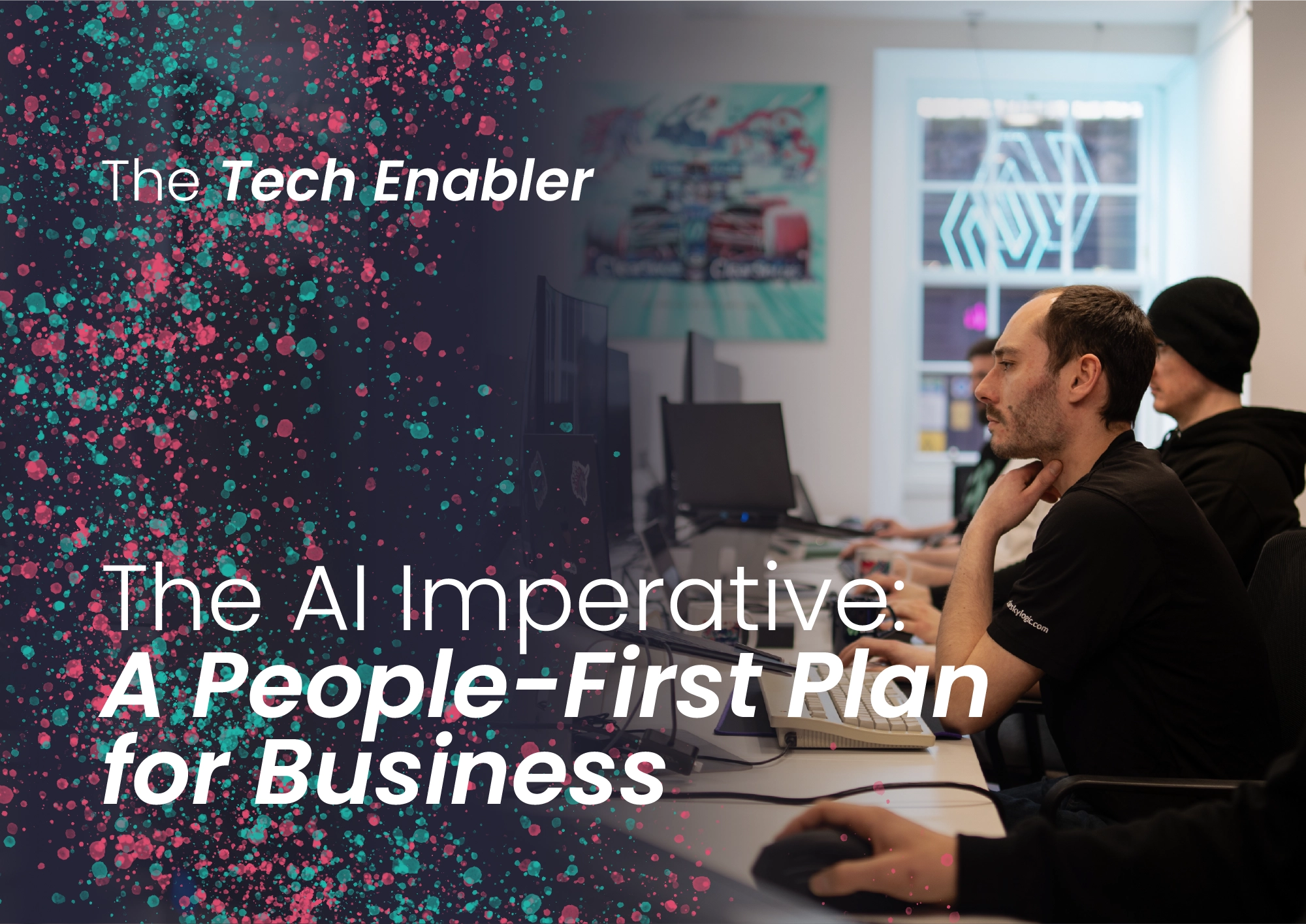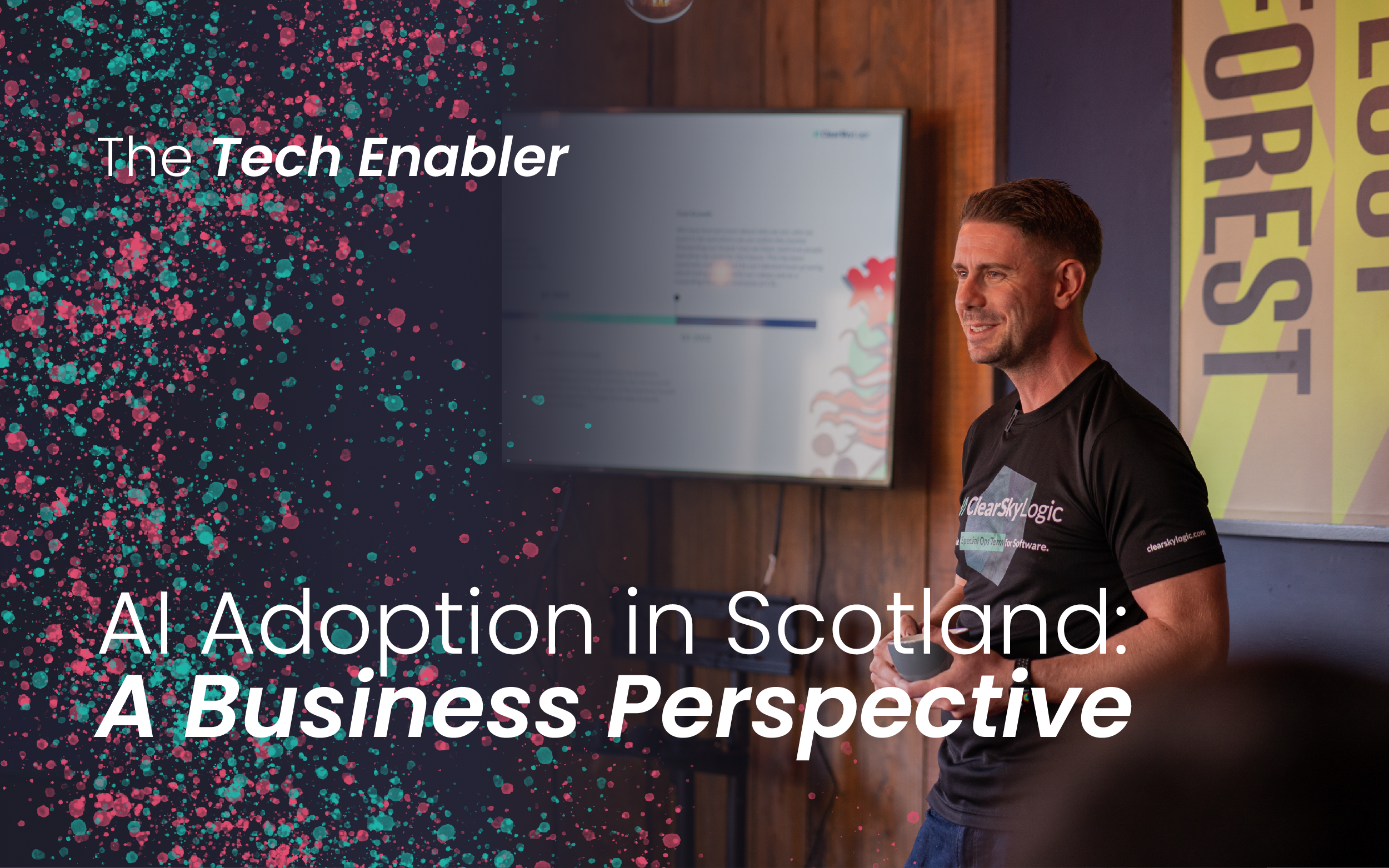The widespread use of AI within organisations is already clear, whether that's from simply using large language models (LLMs) to help with note-taking, documents, or research, or within the development world with tools like Cursor. AI is quietly filtering into our working processes across businesses in all sectors. Its effect on people and teams, in regard to their productivity, skills, and ability, is clear. But as leaders, how do we ensure we introduce and implement AI to empower our teams? How do we address the worries and concerns team members have of being replaced? How do we ensure we don't lose skills and knowledge through corner cutting or an over-reliance on AI?
At ClearSky Logic, we are not only working with clients on their AI solutions, but we are also giving our leaders time to think, plan, and continue to develop our internal AI strategies. Looking at AI as simply an efficiency tool is short-sighted. As AI evolves, the efficiency improvements will be nothing compared to the power it gives our problem-solvers and creative minds.
Our approach to this has been thoughtful and, most importantly, centered on our people. We recently surveyed our internal dev teams to look at how they are already using AI internally and outside of work. We wanted to look at what tools they are using, what their thoughts and opinions were, and more widely, their feelings around AI and the opportunities or issues they felt it created for them.
Where it started
The first insight from our internal discovery process was that the AI revolution wasn't coming; it was already here. Without a top-down directive, a significant majority of our team, from junior developers to senior architects, were already using AI-powered tools on a daily or weekly basis. This was a grassroots movement happening in pockets across the company, with applications as diverse as our talent:
- AI-Assisted Development: Our engineers were leveraging AI coding assistants to accelerate development, refactor complex code, and generate unit tests, effectively augmenting their core craft.
- Generative Content and Research: Our teams were using generative chatbots to brainstorm ideas, summarise dense documentation, and sharpen communications.
- Intelligent Workflow Automation: We found early explorations into using AI to generate boilerplate code, create test data, and streamline repetitive tasks.
There was enthusiasm, but so was the fragmentation. There was no shared safety manual, no advanced training program, and no unified vision for what we could build together.
The Human Perspective
No technology as transformative as AI can be understood through usage statistics alone. The most profound insights came from the open-ended questions, the hopes, and frank assessments our team shared.
The blockers were clear and aligned with the wider industry conversation. Concerns about the accuracy and reliability of AI outputs were paramount. Questions around data privacy and security were, rightly, top of mind. But the dialogue went deeper, revealing two critical areas of tension:
- The Fear of De-skilling: A recurring theme was the concern that over-reliance on AI could devalue the learning process. One team member articulated a fear of creating a generation of developers who could prompt an AI to produce code but couldn't reason about its structure or debug it from first principles. AI can provide the what with impressive speed, but true expertise is built on understanding the why. An AI strategy that stifles human learning is not a strategy; it's a liability.
- The Expert’s Paradox: We uncovered a fascinating tension among our most experienced professionals. While some saw AI as a powerful tool, others expressed scepticism or felt it could negatively impact their role. This isn't simple resistance to change; it's a feeling that a tool offering a "shortcut" can be a threat to hard-won expertise. The challenge, then, is to reframe: from a mindset where AI is seen as a competitor, to one where it is seen as its amplifier.
The Plan
With this understanding of our people, we designed a multi-faceted blueprint that addresses the technical, cultural, and ethical dimensions of this transformation. Our plan is built on four core pillars:
- Establish the Foundations: With any new technology, developing a living, evolving Responsible AI Framework is key. It's an operational commitment that provides clear guidelines on data handling, model transparency, and security protocols for every AI project. Our goal is to empower our teams to innovate with speed and safety, knowing they are operating within a framework that protects both our clients and our company.
- The Flagship Strategy – Prove, then Permeate: The temptation is to sprinkle AI across dozens of small internal projects. We're choosing a different path. Our core strategy is to rally our top talent around ambitious, commercially-focused AI prototypes that solve complex, real-world client problems. By building these flagship prototypes, we are allowing our team members to innovate new processes for data engineering, model development, and creative solutions to bottlenecks we know businesses have. Developing these prototypes continues to be a process that allows our teams to develop the proper structures and guardrails for security, compliance, and wider ethics.
- Cultivate a Culture of Expert Amplification: This pillar directly addresses the "Expert’s Paradox." Our goal is to make AI the ultimate tool for our senior talent. We envision a future where an experienced architect can direct a team of AI agents to explore multiple solution architectures in parallel. The goal is to give our experts more pairs of hands, automating mundane tasks so they can focus on the strategic, creative, and complex work that only they can do.
- Democratise Innovation (Responsibly): Our flagship prototype project is allowing us to democratise innovation and ideas. By providing sanctioned tools, internal data sandboxes, and reusable templates, we are empowering every team to build their own solutions safely and effectively. This is creating deep expertise, which is then used to empower decentralised innovation, which in turn uncovers new opportunities and talent.
The noise around AI is loud, but as always when leading teams, understanding and communication is essential. If you are developing your business's AI strategy, or looking at how you can implement new tools, put your team at the heart of the process, and have open and honest conversation about the wider topics.
Suggestions for how to encourage and support your team:
- Foster a Culture of Psychological Safety: Encourage open dialogue about the fears and concerns of your team members.
- Provide Dedicated Time for Experimentation: Don't expect your team to learn new tools on their own time. Schedule time where they can test tools and ideas in a low-pressure environment.
- Focus on Augmentation, Not Replacement: Consistently reframe the conversation around how AI will amplify human expertise, not replace it. We are in an exciting age for the problem solvers and creative thinkers.
- Invest in Training: Provide formal training programs, workshops, and peer support. This not only builds skills but also establishes best practices and a shared knowledge base.
- Share AI-Augmented Successes: Publicly share and reward team members who are effectively using AI to solve problems, improve their workflow, or deliver better results. This encourages a positive culture of adoption.
- Establish Clear, Responsible Guidelines: Create clear, well-communicated internal guidelines on data privacy, security, and ethical use of AI tools. This provides the necessary guardrails for your team to experiment safely and responsibly.
- Lead by Example: Leaders should openly discuss their own use of AI tools and share their learning journey. This demonstrates that it's okay to experiment and that the company is fully committed to this transformation.


.svg)





